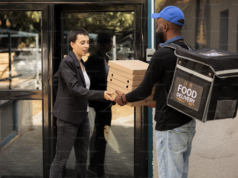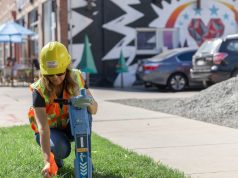Earthcube is a developer of monitoring solutions based on an automated analysis of geospatial information. It combines Earthcube’s artificial intelligence technics in both Computer Vision and Machine Learning. COO Ségolène Husson explains some of the background machinations behind the products of this French start-up.

The company was founded in 2016 by two engineers. The CEO, Arnaud Guérin, came out of the energy sector and Renaud Allioux, PhD, co-founder and CTO, has worked in Airbus Defence and Space. Ségolène Husson, COO at Earthcube, has been working for the company for more than two years now. She witnessed Earthcube’s first fund raising, which took place in 2017. Result: three million Euros. Two and a half years from then, the company now accumulates a total of seven million Euros raised since its foundation.
Artificial Intelligence
As of today, they have forty employees, of which approximately 85 per cent work on Earthcube’s artificial intelligence (AI) and related technical fields. As Husson explains: “We have developed expertise in automating the analysis of satellite imagery through AI. Basically, we are an AI company.” This has not always been the case. “In the very beginning, the idea of the co-founders was to work on both hardware and software. Initially, they wanted to build their own satellites and sensors and develop the software to analyse the incoming data. They then realised that, considering the great number of actors already building constellations of satellites, the real added value of the company would come from focusing on software.”
Aggregating knowledge
“These days, lots of companies are doing AI. At least, they claim they are doing it. Our expertise in AI, having so many people working in R&D, is quite broad. We have taken people from different fields. They have been working on medical imagery, autonomous vehicles or video games. This way we are aggregating a lot of knowledge taken from different sectors in order to apply it to satellite imagery.” Their challenge is to be able to automatically analyze the data and to understand which part of it is relevant.

Is Artificial Intelligence a black box?
“There is no black box!”, Ségolène Husson exclaims, “This is pretty much why we like to talk about it. People who state that AI is a black box are usually not able to explain it well. We are. We detect, segment and classify objects of interest for our customers. Therefore, we develop object detection algorithms. We have a database of approximately three million objects. They are labelled. They belong to us. Then we train our algorithms on that base. We can detect cars, roads, aircraft, boats, buildings, you name it. We can tell you if an object is civil or military, if they are boats or aircraft. But we know even go further in the classification, since the AI is for instance able to recognize up to 89 types of aircraft, automatically. Of course, it all depends upon our customers’ needs.”
Read more: French start-up Kinéis is the first fully financed IoT nanosatellite constellation
Is it correct that it is more interesting for you to encompass stretched fields and larger landscapes?
“Yes. You want to be able to monitor large regions. Our technology is often used to detect objects that only exist in a limited number of instances across a large number of images.” Earthcube’s Artifical Intelligence proprietary solution, S-Cube, is also communicated as being a Strategic Sites Surveillance-tool. The SaaS platform enables the monitoring of areas of interest, but can also be implemented on premise, seamlessly integrating with existing systems, depending on Earthcube’s customers’ needs.
Earthcube’s raw materials are typically raster data (imagery). How is the transition taking place when detecting objects? Is this a process where vector data enter the picture, so to speak?
“We take images, as raster files, and then detect objects in vector. It is based on segmentation and indexing. We take the centre in a polygon, we detect and then classify.”
Once liberated from all redundant and useless images, with a nice batch of tracked changes, there still might be stuff that you want to look at?
“Exactly. Although we managed to reach super high performances, it is never a full 100 per cent accurate. Our algorithms are reaching performances above 90%, already matching human eyes’, and our customers can attest of performances above 95% on their proprietary data.”
Read more: 12th European space conference focus on growth climate and security
Where does GIS functionality stop and where would you start calling it Artificial Intelligence (AI)?
“That is not easy to determine. In short, AI is about algorithms, GIS is about geospatial data. AI can either be an algorithm thanks to which you will understand the meaning of an aggregated map. Otherwise, a good understanding of a map helps you decide whether an algorithm can help you get more out of it. Ultimately, AI comes in when there’s a need to extract information from the data. In GIS we just select and manipulate.”
Earthcube is on the ground side of things. There is no dependency when it comes to data providers?
“That’s correct. We work with several image providers, depending on the resolution we need. Digital Globe, which is a Maxar company, or Planet for the most precise commercial resolution. But we are also using Sentinel data, European Space Agency’s open source data and Airbus data. All we do is buy their images. We can pretty much process any kind of imagery. We also work with aerial or drone pictures, but our expertise is in satellite imagery.”
Potential customers
A satellite image contains a large amount of information, but to an experienced photo-interpreter, its analysis can take up to a day. Husson explains: “We design our products for all those analysts who, up to now, are used to watching images one by one. Usually the task is time-consuming, and 90 per cent of all images go to the trash. And that’s not because the imagery is no good. They do not have enough resources to process it all. This way, critical information is being put to bin. Simply because a lack of time to treat it. Thanks to S-Cube, 100% of the data is now analysed.”
Your customer is typically a specialist who understands algorithms given classifications?
“It’s a bit broader than that. In short, on S-Cube, there are two views of the output. The image itself is for analysts who are used to look into satellite source images of the related zone. They would be able to recognise that our algorithms performances are actually really good. Because, as a human being specialised in it, he or she can tell that it is true and happening. Apart from this, you also can view dashboards to follow the evolution of the site looked at. This is a fitting way to present information to decision makers and other people who are not used to watching images.” Among the flow of information available is the generation of PDF reports and a customized alarm system, where thresholds are set up by analysts themselves depending on the type of object or their location on the image.

Defence
“At this stage, our main focus is defence”, Ségolène Husson explains. “That’s because we have worked very successfully with former military analysts.” Defence specialists use Earthcube’s artificial intelligence products to monitor sites of interest in relation with the current main conflicts. “The defence industry requirements and constraints force us to have the best detections ever because they cannot do just ok, they have to do really great. They need information that they can trust and reliable, it is paramount for them. So it is also interesting for us to work with them. It forces us to always improve our performances.”
Civil use cases
“We also work on civil applications. After all, it’s all about object detection.” One striking example is the data category dealing with infrastructure, construction and industry. Stakeholders can assess natural catastrophes damages, road construction evolution, or even monitor hard to access infrastructures using Earthcube’s outcomes. Husson steers back to defence: “We can service both sectors, civil and military. But right now, the idea is to create and develop products with defence specialists: if you fit the most demanding requirements, you fit them all. We are not randomly designing products based on vague hopes and dreams: ‘let’s build a platform which could be of use for them’. We are actually building it with them to make sure that it is of high value to use afterwards.”




